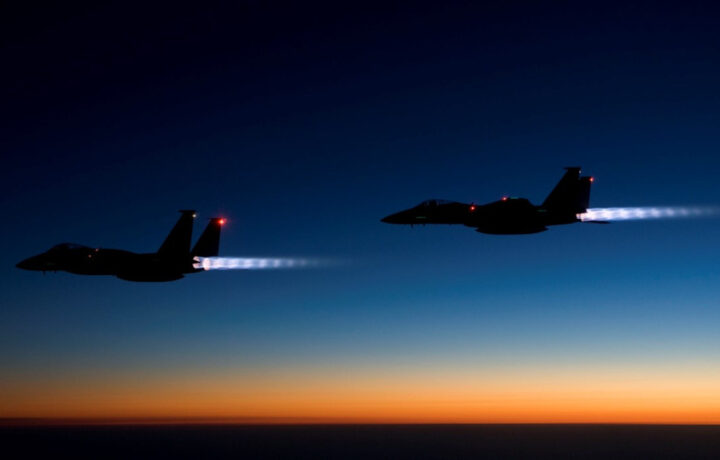As part of its $185.1 billion Fiscal Year 2024 (FY24) budget, the United States Air Force has sought to retire more than 300 legacy aircraft from its fleet – but the service may be forced to keep some of the older warbirds in flight for a few more years.
Lawmakers from the House Armed Services tactical air and land forces subcommittee have approved the Air Force’s request to clip the wings for fifty-seven F-15C/D Eagles, some of which are nearly four decades old and are reaching the end of their service lives. In addition, the Air Force will be allowed to retire forty-two A-10 Thunderbolt II ground attack aircraft next year as part of the House of Representative’s proposed FY24 National Defense Authorization Act (NDAA), which was unveiled on June 12.
In total, 99 jets could be allowed to be put on the chopping block.
The full committee will meet later this month to vote on amendments, and to complete its version of the NDAA, which then must clear the full House. Of course, the Senate must also pass its version of the bill, and the two versions will still need to be reconciled in a conference process that could see other changes.
However, it is clear that the Air Force isn’t exactly getting everything it had desired.
The A-10s Keep Flying
Air Force officials had sought to retire an even larger number of the A-10s, and with this reduction, it will still be left with 218 of the aircraft. The service had suggested the rugged attack aircraft, which first entered service in the early 1970s – and which were employed to good success in air support missions in Afghanistan and Iraq during the Global War on Terror (GWoT) – aren’t suited to threats against near-peer adversaries including China and Russia.
There have been repeated calls from Air Force officials to Congress to allow it to start retiring the A-10, arguing that the airmen and resources that are now used to keep the Thunderbolt IIs flying could be better employed on newer and more survivable jets.
It was only last year that U.S. lawmakers allowed for the service to retire the first twenty-one A-10s this year. It now appears that a few more could fly on to retirement. And there are even opinions by some on Capitol Hill that the A-10 – known as the Warthog by its pilots – could still be suited to a combat role against Russia, just not with American pilots
Earlier this month Senator Marco Rubio (R-Florida) wrote an op-ed in which he suggested the A-10s be provided to Ukraine, instead of any future F-16 Fighting Falcons that are supplied to Kyiv. Rubio argued that the A-10, which can operate from remote airfields, including those with dirt runways, are better suited than the F-16s, which require extensive support capabilities as well as a 7,000 foot long runway.
F-22 Raptors Will Remain in Service
One area where lawmakers and U.S. Air Force officials are unlikely to find common ground is in the future of the F-22 Raptor, the Lockheed Martin fifth-generation air superiority fighter that entered service as the U.S. was involved in the GWoT. It proved ill-suited to that conflict, and while it is still considered among the best combat aircraft in the world, many are not able combat capable the Air Force has warned.
The service sought to see thirty-two F-22 Raptors retired, arguing that the fifth-generation air superior fighters aren’t combat certified.
In April, Air Force leaders told the House Armed Services Committee that the savings would go to research, development, testing, and evaluation for future platforms – notably the Next Generation Air Dominance (NGAD) program, which is more than a single aircraft. It is actually reported to be a system of systems that will include a sixth-generation manned aircraft and unmanned Collaborative Combat Aircraft (CCA) also previously known as Loyal Wingmen.
The U.S. Air Force is now seeking to avoid the costly mistakes that plagued past programs including the F-35 Joint Fight Strike fighter. Earlier this year, the Air Force requested $1.9 billion in research and development funds for the NGAD project in its 2024 budget request to Congress.
At issue to lawmakers is that the NGAD is still many years away from fielding and is now only in its earliest stages of development.
Chopping Block
The Air Force had sought permission to retire the Block 20 Raptors, and emphasized that the aircraft are not combat-coded. Last year Congress blocked the aircraft’s retirement, and while there was confidence that the divestments would be granted this year, lawmakers are now unlikely to permit such a move.
“FY23 prohibition on retirements for F-22’s still stands,” a senior committee aide told Breaking Defense earlier this month. “Members view that the F-22 proposal is problematic because the Block 20 is combat capable depending on the threat environment; our most advanced F-22, the Block 30/25 aircraft, would then be required to absorb the training pipeline workload, adding unnecessary wear and tear to our most combat-capable fleet and very small fleet of remaining F-22s.”




